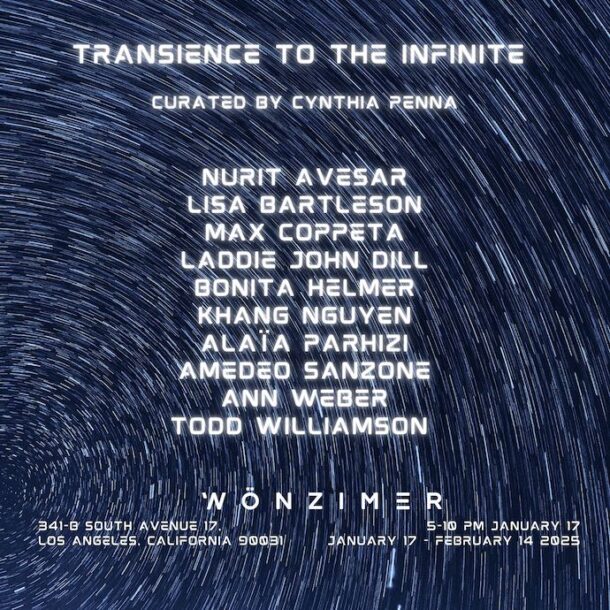
Transience to the Infinite: A Scientific Exploration of Time and Space Curated by Cynthia Penna
Opening: 5 pm-10 pm, Friday January 17th 2025
Dates of Show: January 17th – February 14th 2025
Wonzimer Gallery
341-B S Avenue 17 Los Angeles 90031 / wonzimerinfo@gmail.com
Featuring: Bonita Helmer, Laddie John Dill, Ann Weber, Alaïa Parhizi, Max Coppeta, Todd Williamson, Khang Nguyen, Amedeo Sanzone, Nurit Avesar, Lisa Bartleson
Transience to the Infinite brings together a diverse group of ten artists whose works offer unique perspectives on the ephemeral nature of existence and the boundless possibilities of the universe.
In “God, Science, Evidence: The Dawn of a Revolution”, Olivier Bonnassies, alongside Michel-Yves Bolloré, posits that contemporary scientific research inexorably points to the existence of a Creator God—an assertion that may seem provocative in the realm of empirical inquiry. The authors intertwine cosmology, physics, history, and theology in an ambitious attempt to bridge the oft- assumed divide between faith and reason. The premise is bold: “With the discovery of thermodynamics,” they argue, “we learn that the universe is wearing down, heading toward thermal death. If the universe had a beginning… then there must be a God.”
This concept hinges on three core scientific principles: first, the recognition that the universe is inextricably composed of time, space, and matter; second, the certainty that it had an absolute beginning; and third, that its fine-tuned laws seem almost tailored to allow for the emergence of complex life. With such findings, the authors claim that science itself defines what ancient philosophies and religions have long identified as God—a transcendent, external force that crafted the universe, ultimately allowing for human existence.
Yet, despite these weighty claims, the exhibition tied to this discourse does not seek to validate or refute the existence of such a divine entity. Rather, it aims to explore the nuanced intersection between human experience, daily struggles, and spiritual transcendence—where art becomes a means of navigating the liminal spaces between the physical and metaphysical.
The transcendental, often viewed as timeless and spaceless, resonates deeply with the core of artistic creation. Far from the strict boundaries of scientific inquiry, art ventures into those vast unknowns where metaphysics and human consciousness collide. This exhibition invites viewers to contemplate moments of “divine” revelation, not in the religious sense, but as profound instances in which the mind perceives beyond the material world, tapping into a realm that surpasses time and space.
In art, humanity seeks such revelations—a desire to transcend the mundane and ascend to a higher, perhaps mystical, plane. This echoes across cultural and religious contexts, in which the ultimate goal is to connect with what is often referred to as GOD. The role of art in this quest for spirituality is fundamental. As a visual medium, art provides the vehicle for meditative introspection, offering viewers a window into higher truths.
Saint Paul’s assertion in his Sermon at the Areopagus of Athens that “God created man so that he might seek Him” resonates here, as art becomes the catalyst for such a search—an intimate and often silent dialogue between the viewer and the ineffable.
But what of mysticism in the contemporary era? Is there still space for such contemplation in our material-obsessed world? Wassily Kandinsky provides a prophetic answer. He once remarked on the “tragic collision between matter and spirit” in his era, foreseeing the rupture of a purely materialistic worldview. Kandinsky’s words, spoken over a century ago, describe a cultural crisis that feels remarkably familiar today—a time marked by uncertainty, disorientation, and spiritual yearning.
His own artistic journey shifted from representing the objective world to delving into the inner Klang (the “inner sound” or “inner need”), striving for a spirituality and transcendence that go beyond the mere physical representation of reality.In this sense, Kandinsky’s message is uncannily relevant to our current moment. As we grapple with a world increasingly dominated by superficial material concerns, the existential questions of theearly 20th century resurface. His call for spiritual awakening, through art, suggests that refuge in the spiritual or even in art itself is insufficient on its own. Rather, what is required is a fundamental transformation of our way of being, rooted in introspection and a relentless pursuit of justice—both personal and collective.
This transformation begins with an acknowledgment of our own smallness within the vast, intricate mechanism of the universe. If we could pause to truly grasp the magnitude of what lies “OUT THERE” beyond our limited world, perhaps only then would we see art and introspective thought as the fragile but powerful tools they are: means of reconnecting with a broader, more profound sense of existence.
The exhibition thus calls on us to reflect on this urgency for change. It urges a recalibration of our behaviors, anchored in the realization of our finitude and insignificance in the grand cosmic design. And yet, it also reminds us that, within this immense scope, we have the capacity for profound insight, expression, and—through art—a connection to the infinite.
by Cynthia Penna

